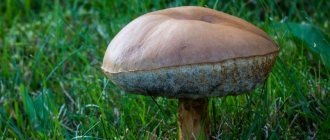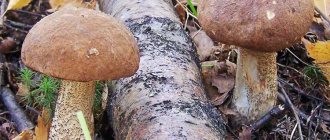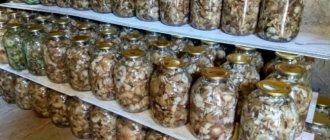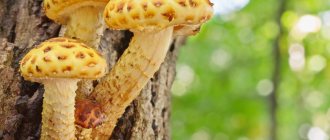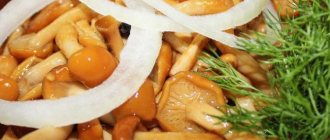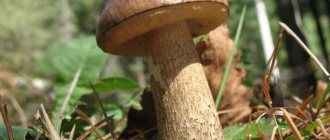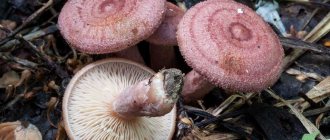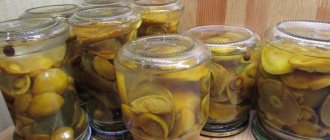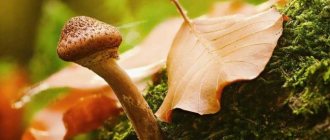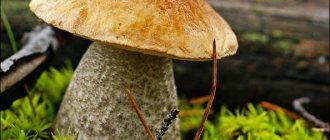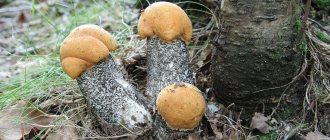Pink boletus is an edible mushroom, widely distributed in the CIS countries. Belongs to the genus Leccinum, family Boletaceae, spongiform group.
A close relative of the boletus. The distinctive properties of the pink boletus are the speckled, marbled pattern of the cap and the flesh turning pink at the break - hence the name.
It has high taste qualities and belongs to the second category. The pulp is dense and aromatic. Requires minimal pre-processing. Therefore, pink boletus has found very wide use in cooking. Suitable for all types of workpieces. It can even be eaten raw.
Boletus turning pink. Latin name : Leccinum oxydabile.
Boletus turning pink. Another name : oxidizing birch (variegated).
Related species
Boletus is a group of species of mushrooms of the genus Leccinum (boletus). In addition to boletus, this genus includes a group of boletus. Representatives of both groups are edible mushrooms.
In addition to the pink boletus species, boletus species include several dozen species. The most common:
- common boletus – Leccinum scabrum;
- gray boletus (hornbeam) – Leccinum carpini;
- Stiff boletus – Leccinum duriusculum;
- marsh boletus – Leccinum holopus;
- black boletus (black cap) – Leccinum melaneum;
- checkerboard boletus (blackening) – Leccinum nigrescens;
- ash-gray boletus – Leccinum leucophaeum;
- colorful boletus – Leccinum variicolor.
Boletus "swamp"
It has a whitish-cream, sometimes with a bluish or greenish tint, a hemisphere-shaped cap, a thin gray leg covered with whitish scales, and watery pulp.
These types of boletus mushrooms belong to category II edible mushrooms. They keep well. When dried, they become almost black, which does not affect their taste. These mushrooms are usually fried, boiled or pickled.
Edible boletus contains about 35% protein, which is enriched with various amino acids. They contain a huge amount of vitamin PP and other micro- and macroelements.
False doubles
The boletus mushrooms are quite similar to each other, and since they are all edible, there will be no harm if, when collecting in a basket, for example, gray or ordinary boletus mushrooms fall in with the pink boletus mushrooms. It is much more important not to confuse them with poisonous mushrooms, which pose a threat not only to human health, but sometimes to human life.
The boletus does not have a pinkish poisonous counterpart, but there is a species that has an external resemblance to it, which cannot be eaten. How to distinguish pink boletus?
False boletus
The false boletus or gall mushroom (Tylopilus felleus) is not poisonous, but it is also not suitable for food, since the taste of its pulp is very unpleasant, bitter, acrid, and does not disappear when cooked, but only intensifies. Even a small piece of false boletus can ruin the entire mushroom dish or preparation.
The main distinguishing features are:
- Unlike the pink boletus, which grows only in the immediate vicinity of birches, gall fungus can also be found in other trees, as well as near rotten stumps, on rotten wood, and near ditches.
- The false boletus has a reddish-green or bright brown cap, while the pink boletus has a characteristic marbled pattern.
- The skin of the boletus cap is pinkish and smooth, unlike the gall mushroom: it is rough.
- The stem of the pink boletus has dark scales characteristic of boletus, and in the false boletus it is covered with a netted pattern, reminiscent of a porcini mushroom, only of a dark color.
- There are no insects on the surface of false boletus, as they are not attracted to its bitter taste.
Taxonomic history
Variegated boletus was described in 1969 by British mycologist Roy Watling, who was working in Edinburgh, Scotland at the time. The term Boletus comes from the Greek bolétes, which the Greeks called a mushroom meaning lump, bush, because it grows among clods or thick places. Others instead believe that the meaning extends to the ball, since the cap of most mushrooms is globular. For some authors, the word comes from the name of the ballets, which the Romans used to designate the best edible mushrooms. The epithet "leccinum" is Latin for "north".
Botanical description
What does a pink boletus look like? The cap is fleshy, strong, and easily separated from the stem. The shape is initially rounded-convex, irregularly rounded, but as the mushroom grows it opens up and becomes rounded-outstretched, cushion-shaped. The edges are slightly wavy. The skin is bare, thin-tomentose, dry. In damp, humid weather it becomes covered with mucus.
The color of the pink boletus cap is: grayish-brown, grayish-brown, dark gray, against which lighter spots appear, reminiscent of a marble pattern. Diameter: 8-15, up to 18-20 cm.
The lower part of the cap (hymenophore) of the pink boletus has long tubes. The pores are small and round. The tubular layer of pink boletus is deeply notched. Color: whitish, cream, becomes dirty, brownish-gray with age. When pressed, it changes to pink and then brownish.
Rose boletus spore powder is ocher-brown.
The leg is round, thin, long, solid, dense, fleshy. In the lower part it is thickened, often curved in the more illuminated direction. Color: off white. Covered with dark gray, almost black scales, most densely located along the fibers into which the cover of the leg breaks. In very young specimens the entire leg may be black. Length of the pink boletus stem: 6-10, up to 12 cm, diameter: 1-2 cm.
The pulp of the pink boletus is dense, spongy, and longitudinally fibrous in the stem. In older mushrooms, the cap becomes more loose and watery, and the stem becomes tougher and more fibrous. White color. When cut, the boletus flesh turns pink and then darkens. Smell: pleasant, mushroom. Taste: sweetish.
Common boletus (Leccinum scabrum)
- Other names for the mushroom:
- boletus
- Obabok
- Berezovik
Synonyms:
Cap: In the common boletus, the cap can vary from light gray to dark brown (the color obviously depends on the growing conditions and the type of tree with which the mycorrhiza is formed). The shape is semi-spherical, then cushion-shaped, glabrous or thin-tomentose, up to 15 cm in diameter, slightly slimy in wet weather. The pulp is white, does not change color or slightly pinkish, with a pleasant “mushroom” smell and taste. In old mushrooms, the pulp becomes very spongy and watery.
Spore-bearing layer: White, then dirty gray, the tubes are long, often eaten by someone, and are easily separated from the cap.
Spore Powder: Olive brown.
Leg: The length of the common boletus leg can reach 15 cm, diameter up to 3 cm, solid. The shape of the leg is cylindrical, somewhat widened below, gray-whitish, covered with dark longitudinal scales. With age, the flesh of the leg becomes wood-fibrous and hard.
Distribution: Common boletus (Leccinum scabrum) grows from early summer to late autumn in deciduous (preferably birch) and mixed forests, in some years quite abundantly. It is sometimes found in surprising quantities in spruce plantings interspersed with birch. It produces good yields in very young birch forests, appearing there perhaps first among commercial mushrooms.
Similar species: The genus Common boletus has many species and subspecies, many of them are very similar to each other. The main difference between the “boletus” (a group of species united under this name) and the “boletus” (another group of species) is that the boletus turns blue at the break, while the boletus does not. Thus, it is easy to distinguish them, although the meaning of such an arbitrary classification is not entirely clear to me. Moreover, in fact, among the “boletus” there are also species that change color - for example, the pink boletus (Leccinum oxydabile). In general, the further into the forest, the more varieties of boletaceae there are.
It is more useful to distinguish the common boletus (and all decent mushrooms) from the gall mushroom. The latter is distinguished, in addition to its disgusting taste, by the pinkish color of the tubes, the special “greasy” texture of the pulp, a peculiar mesh pattern on the stem (the pattern is like that of a porcini mushroom, only dark), a tuberous stem, unusual places of growth (around stumps, near ditches, in dark coniferous forests, etc.). In practice, confusing these mushrooms is not dangerous, but it is annoying.
Edibility: Common boletus is a normal edible mushroom. Some (Western) sources indicate that only the caps are edible, and the stems are supposedly too tough. Absurd! The cooked caps are distinguished by a nauseating gelatinous consistency, while the legs always remain firm and collected. The only thing that all reasonable people agree on is that the tubular layer of older mushrooms must be removed. (And, ideally, taken back to the forest.)
Author's notes: Despite its apparent commonality, the common boletus is a rather mysterious mushroom. Firstly, fruiting. For several years it can grow in Homeric quantities anywhere and everywhere. In the early 90s, in the Naro-Fominsk region, boletus was, without exaggeration, the most common mushroom. It was loaded with buckets, troughs, trunks. And one year he disappeared, and he is still not there. There were still enough whites (despite the crowds of greedy summer residents), but the boletus disappeared. From time to time you only come across monstrous monsters: small, thin, crooked.
In the summer of 2002, for obvious reasons, there were no mushroom pickers at all, so what do you think? occasionally we came across quite decent boletus mushrooms. Something will happen next time, I thought.
And the next time was not long in coming. The summer and autumn of 2003 turned out to be so fruitful that all speculation about the degeneration of the boletus can be safely consigned to the dustbin of opinions. The common boletus went in June and went and went and went without a break until the beginning of October. The field, overgrown with young birch trees, was completely trampled by mushroom pickers - but not a single good person returned without a bag of these common boletus. The forest edges seemed to be cluttered with stools. Three times in a row (without missing a day) I could not get to the place where I expected to meet a black milk mushroom, my character let me down: I immediately grabbed all the young and strong Boletus capillaries that I saw, and after 100 meters my trip ended: banal there was no container. I am sure that for many years the 2003 season will be remembered as a fairy tale, but then the feelings were different. It seemed that the value of boletus was being devalued literally before my eyes.
Habitat
Pink boletus is common in North America and Eurasia, in their northern part and in the tundra. Prefers moist, moist soils.
Where does the pink boletus grow? The plant forms mycorrhiza (symbiosis with the roots of the plant) with birch, and therefore settles in close proximity to it.
Where to collect pink boletus? The mushroom can be found in birch, pine-birch and mixed forests, in glades, forest edges, highlands, outskirts of lakes, swamps, and peat bogs. Forms small groups of 2-3 copies.
Calories and nutritional value
The pink boletus plant is a valuable food product, contains a rich set of vitamins, macro- and microelements, and is a source of protein. At the same time, the calorie content of pink boletus is low (per 100 grams of product), which will be appreciated by people watching their weight:
| Name | Quantity, gr. |
| Calories, kcal | 20 |
| Squirrels | 2,1 |
| Fats | 0,8 |
| Carbohydrates | 1,2 |
| Water | 90,1 |
| Cellulose | 5,1 |
Important! The information presented in the material is for informational purposes only. Before use, be sure to consult a specialist.
How to collect
The harvest season for pink boletus begins in June and ends with the first frost. The first specimens can be found as early as May. But the mass season occurs at the end of August - beginning of September.
Harvesting of pink boletus should be carried out only in damp, humid weather, since in dry times the development of the mycelium stops and you can be left without mushroom trophies.
Where to collect pink boletus? The mushroom grows not only on large roots and in the immediate vicinity of birch trees. It can often be found above young roots at a certain distance from the tree. Likes to camouflage among tall grass and moss. Prefers bright, well-lit places. Therefore, you should be careful and patient when searching.
As the mushroom matures, undesirable changes occur in the structure of the pulp, both the cap and the stem, and its taste deteriorates. Therefore, only young specimens are suitable for collection.
How to prune pink boletus? The mushroom is carefully cut off at the base with a sharp knife so as not to damage the mycelium. This will allow you to get a harvest in this place in the next season.
Growing
Basidiomycetes are being actively cultivated. At home, you can easily grow a clearing with delicious mushrooms in your garden plot. You can plant spores collected yourself at your dacha or buy ready-made mycelium. The basidiomycete will bear fruit well in an area where there are birch trees that are 2 to 4 years old.
If you need to collect spores with your own hands, select several old fruiting bodies. At a distance of 50 cm from the trunk, beds are made with a depth of 21-31 cm. Crushed stone is laid on the bottom, then coarse sand and a turf mixture. All this needs to be covered with a layer of high-quality compost.
If the hymenophore collected from mushrooms is hard, it is better to soak it together with gelatin and dolomite flour in a ratio of 1: 0.2: 0.3. The mixture is placed in the holes, covered with compost, and mulched on top with a turf mixture. Consistently high soil moisture is maintained within 70%. To successfully grow a product on a plot, special attention should be paid to harvesting. The main thing is to ensure that the mycelium that produces the shoots is not destroyed, otherwise this will be the last harvest.
An easier option is to buy a kit for a beginner, which includes a special basket with “seed” material, substrate and detailed instructions. You can easily find them in any specialty store.
How to process
Pink boletus is one of the mushrooms that require minimal preliminary preparation before cooking:
- Mushrooms are sorted and wormy and rotten specimens are discarded.
- Clean the surface from forest litter.
- There is no need to soak the pink boletus mushrooms; just rinse them thoroughly in running water.
The next step is cleaning, the technology of which is different for the cap and stem of the mushroom. Based on this, the caps are separated from the legs.
hat
First, remove the skin from the cap. You can't scrape it off. Proceed as follows: use a knife to grab its edge and, holding it with your finger, pull it off.
Next comes the cutting. Small caps (up to 3 cm) are left whole, medium ones (4-7 cm) are divided into 2-4 parts, large ones are cut into randomly uniform pieces.
Leg
The leg is first scraped to remove scales. Then cut into several parts. Small legs are left whole.
How to cook
The pink boletus has dense, fleshy pulp, a rich, rich mushroom aroma and a sweetish, delicate taste. It performs well boiled, fried, stewed, baked. You can even eat it raw. Therefore, there are a lot of recipes for preparing pink boletus. Often serves as a filling for pies, pizza, rolls, etc.
However, it should be noted that the structure of the flesh of the cap and the stem is different. The legs, being tougher, require longer heat treatment, so they are more suitable for preparing soups, sauces, and main courses. Pairs well with vegetables and meat.
The disadvantage of pink boletus is that after heat treatment it turns black. This is not a sign of spoilage and does not affect the quality of the finished dish. The taste and aroma properties remain unchanged.
Definitioner
Basidia (Basidia)
Lat. Basidia. A specialized structure of sexual reproduction in fungi, unique to basidiomycetes. Basidia are terminal (end) elements of hyphae of various shapes and sizes, on which spores develop exogenously (outside).
Basidia vary in structure and method of attachment to hyphae.
Based on the position relative to the axis of the hyphae to which they are attached, three types of basidia are distinguished:
Apical basidia are formed from the terminal cell of the hypha and are located parallel to its axis.
Pleurobasidia are formed from lateral processes and are located perpendicular to the axis of the hypha, which continues to grow and can form new processes with basidia.
Subbasidia are formed from a lateral process turned perpendicular to the hyphal axis, which stops growing after the formation of one basidium.
Based on morphology:
Holobasidia are single-celled basidia, not divided by septa (see Fig. A, D).
Phragmobasidia are divided by transverse or vertical septa, usually into four cells (see Fig. B, C).
By type of development:
The heterobasidium consists of two parts - the hypobasidium and the epibasidium developing from it, with septations (see Fig. C, B) or without them (see Fig. D).
Homobasidia is not divided into hypo- and epibasidia and in all cases is considered to be holobasidium (Fig. A).
The basidium is the site of karyogamy, meiosis, and the formation of basidiospores. Homobasidy, as a rule, is not functionally divided, and meiosis follows karyogamy. However, the basidia can be divided into probasidium, the site of karyogamy, and metabasidium, the site of meiosis. Probasidium is often a resting spore, for example in rust fungi. In such cases, the probasidium germinates into a metabasidium, in which meiosis occurs and on which basidiospores are formed (see Fig. E).
See Karyogamy, Meiosis, Hypha.
Pileipellis
Lat. Pileipellis, skin - a differentiated surface layer of the cap of agaricoid basidiomycetes. The structure of the skin in most cases differs from the inner flesh of the cap and may have a different structure. The structural features of pileipellis are often used as diagnostic characters in descriptions of fungal species.
Based on their structure, they are divided into four main types: cutis, trichoderma, hymeniderma and epithelium.
See Agaricoid fungi, Basidiomycete, Cutis, Trichoderma, Hymeniderma, Epithelium.
Contraindications
Whatever the useful product and whatever gastronomic qualities it has, before use you should always take into account not only the benefits, but also the contraindications of pink boletus. The mushroom should not be eaten if you are allergic to mushrooms. If you are prone to allergic reactions, you should exercise caution and include pink boletus in your diet gradually, starting with a small amount.
Since mushrooms are a rather difficult product for the digestive system, they are not recommended for children under 7 years of age.
Literature:
Serzhanina G.I. Cap mushrooms of Belarus.
Lyakhov P.R. Encyclopedia of mushrooms.
Benefit
Boletus mushrooms perfectly strengthen the heart muscle and stimulate blood circulation. Also suitable for those who want to say goodbye to extra pounds by destroying fat cells and cleansing the intestines. Regular consumption of pink boletus normalizes the functioning of the kidneys and nervous system, cleanses blood vessels, lowering cholesterol and sugar levels. It is impossible not to note the positive effect on the bone marrow and musculoskeletal system.
